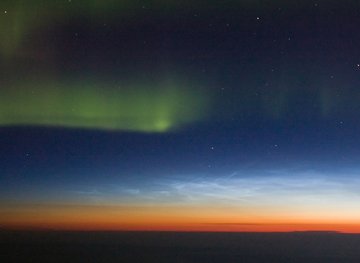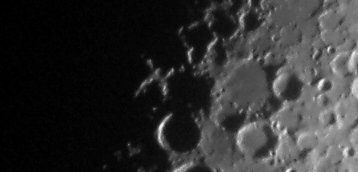| METEOR WATCH: Keep an eye on the sky this weekend. Earth is entering a broad stream of debris from Comet Swift-Tuttle, the source of the annual Perseid meteor shower. Although the shower does not peak until Tuesday, August 12th, don't be surprised to see a number of "early Perseids" making their appearance in the nights ahead: full story. DOUBLE DISPLAY: This morning on an international flight from Los Angeles to London, Jeff Hapeman looked out the window of his plane as it passed 11,000 meters over Greenland and witnessed two beautiful polar phenomena--the aurora borealis and noctilucent clouds: 
Photo details: Canon Rebel XSi, 24mm lens, f/1.4, 1.6s, ISO 1600
"I've seen auroras on these flights before," says Hapeman, "but this was my first sighting of noctilucent clouds. They were very luminous--remarkably bright and electric blue in color." Another double display could be in the offing. On August 10th, a solar wind stream is due to hit Earth, possibly sparking auroras, while noctilucent clouds are almost constantly present at high northern latitudes at this time of year. Sky watchers, book your flight. And don't forget to pick the window seat. LUNAR X: Have you seen the Lunar X? Once a month when the sun rises over Crater Werner in the Moon's southern hemisphere, sunlight floods the region's high terrain and makes a luminous criss-cross shape. Dana Thompson of Hebron, Ohio, sends this photo of an X he witnessed in Jan. 2007: 
The effect lasts only about two hours so careful timing and a little luck is required to catch it. "Observing the 'X' has little or no scientific value. It is a trick of the light. But the effect is striking, and it is exciting to rediscover each month," writes David Chapman in "A Fleeting Vision near Crater Werner" (Journal of the Royal Astronomical Society of Canada, Vol. 101, Issue 2, p.51). The next apparition: Friday, August 8th, starting at 2306 UT (7:06 pm EDT). Submit your Xs here. more images: from Eric Allen of Observatoire du Cégep de Trois-Rivières, Champlain, Québec, Canada; from Roger Vail of Brackley Beach, Prince Edward Island, Canada; from Mario J. Avila-Sobarzo of Santiago, Chile
UPDATED: Solar Eclipse Photo Gallery
[interactive eclipse map] | 
